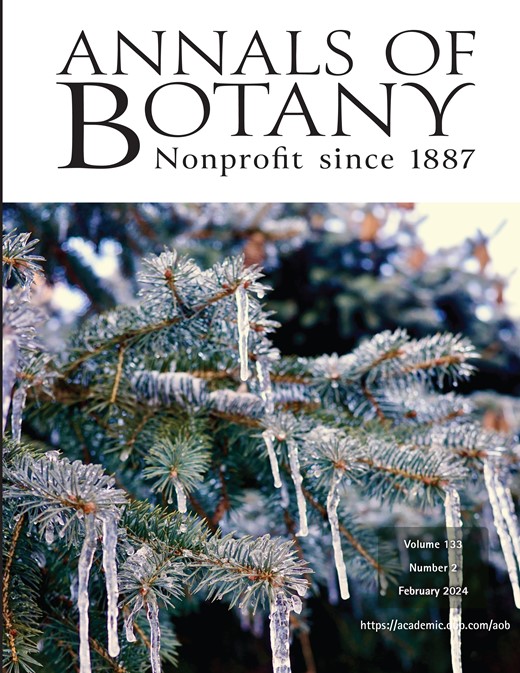
Volume 133, Issue 2
1 February 2024
Cover image

Cover image

The cover image shows icicles formed over buds at the end of stems of a Meyer Spruce (Picea meyeri) following freeze-thaw cycles after snowfall at the Arnold Arboretum of Harvard University, in Boston, MA, USA (accession number 1341-78*B). This reflects the fluctuation between growth permissive environments with warm temperatures and below freezing temperatures that plants must endure, particularly during spring in temperate climates, and thus the duality between cold hardiness and budbreak. (See Kovaleski et al., pp. 217–224.) [Photo credit: Jacob Suissa]
ISSN 0305-7364
EISSN 1095-8290
Issue navigation
Volume 133, Issue 2, 1 February 2024
COMMENTARY
Recurrent allopolyploidy and its implications for conservation in vascular plants: a commentary on ‘Population genomics of the Isoetes appalachiana (Isoetaceae) complex supports a “diploids-first” approach to conservation’
Thaís Elias Almeida and Bárbara Simões Santos Leal
Annals of Botany, Volume 133, Issue 2, 1 February 2024, Pages i–ii, https://doi.org/10.1093/aob/mcad201
This article comments on:
David Wickell, Jacob Landis, Elizabeth Zimmer and Fay-Wei Li, Population genomics of the Isoetes appalachiana (Isoetaceae) complex supports a ‘diploids-first’ approach to conservation, Annals of Botany, Volume 133, Issue 2, 01 February 2024, Pages 261–272, https://doi.org/10.1093/aob/mcad180
PERSPECTIVE
Time to budbreak is not enough: cold hardiness evaluation is necessary in dormancy and spring phenology studies
Michael G North and Al P Kovaleski
Annals of Botany, Volume 133, Issue 2, 1 February 2024, Pages 217–224, https://doi.org/10.1093/aob/mcad182
INVITED REVIEW
Cretaceous chloranthoids: early prominence, extinct diversity and missing links
Else Marie Friis and others
Annals of Botany, Volume 133, Issue 2, 1 February 2024, Pages 225–260, https://doi.org/10.1093/aob/mcad137
ORIGINAL ARTICLES
Population genomics of the Isoetes appalachiana (Isoetaceae) complex supports a ‘diploids-first’ approach to conservation
David Wickell and others
Annals of Botany, Volume 133, Issue 2, 1 February 2024, Pages 261–272, https://doi.org/10.1093/aob/mcad180
Sexual attraction with pollination during feeding behaviour: implications for transitions between specialized strategies
Ryan D Phillips and others
Annals of Botany, Volume 133, Issue 2, 1 February 2024, Pages 273–286, https://doi.org/10.1093/aob/mcad178
Cooperation of an external carbonic anhydrase and HCO3– transporter supports underwater photosynthesis in submerged leaves of the amphibious plant Hygrophila difformis
Genki Horiguchi and others
Annals of Botany, Volume 133, Issue 2, 1 February 2024, Pages 287–304, https://doi.org/10.1093/aob/mcad161
Developmental stages and episode-specific regulatory genes in andromonoecious melon flower development
Giuliano S Pechar and others
Annals of Botany, Volume 133, Issue 2, 1 February 2024, Pages 305–320, https://doi.org/10.1093/aob/mcad186
Mechanisms of grapevine resilience to a vascular disease: investigating stem radial growth, xylem development and physiological acclimation
Ninon Dell’Acqua and others
Annals of Botany, Volume 133, Issue 2, 1 February 2024, Pages 321–336, https://doi.org/10.1093/aob/mcad188
Fertilization benefits the facultative parasitic plant Rhamphicarpa fistulosa while gains by the infected host Oryza sativa are marginalized
Jonne Rodenburg and others
Annals of Botany, Volume 133, Issue 2, 1 February 2024, Pages 337–348, https://doi.org/10.1093/aob/mcad190
Characterizing subgenome recombination and chromosomal imbalances in banana varietal lineages
Janet Higgins and others
Annals of Botany, Volume 133, Issue 2, 1 February 2024, Pages 349–364, https://doi.org/10.1093/aob/mcad192
Quantifying differences in plant architectural development between hybrid potato (Solanum tuberosum) plants grown from two types of propagules
Jiahui Gu and others
Annals of Botany, Volume 133, Issue 2, 1 February 2024, Pages 365–378, https://doi.org/10.1093/aob/mcad194
Advertisement
Advertisement


